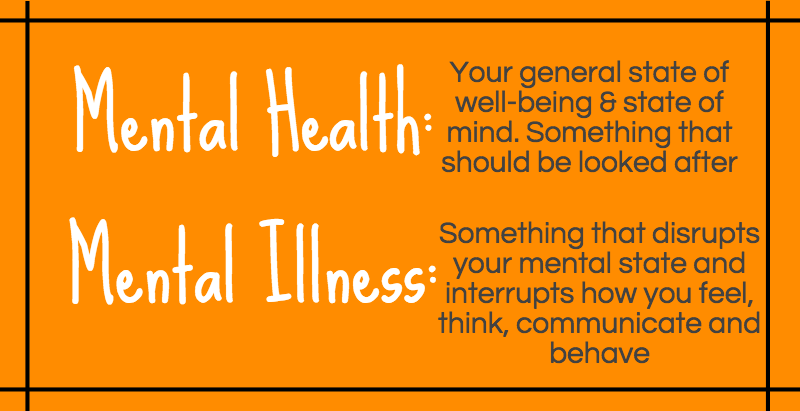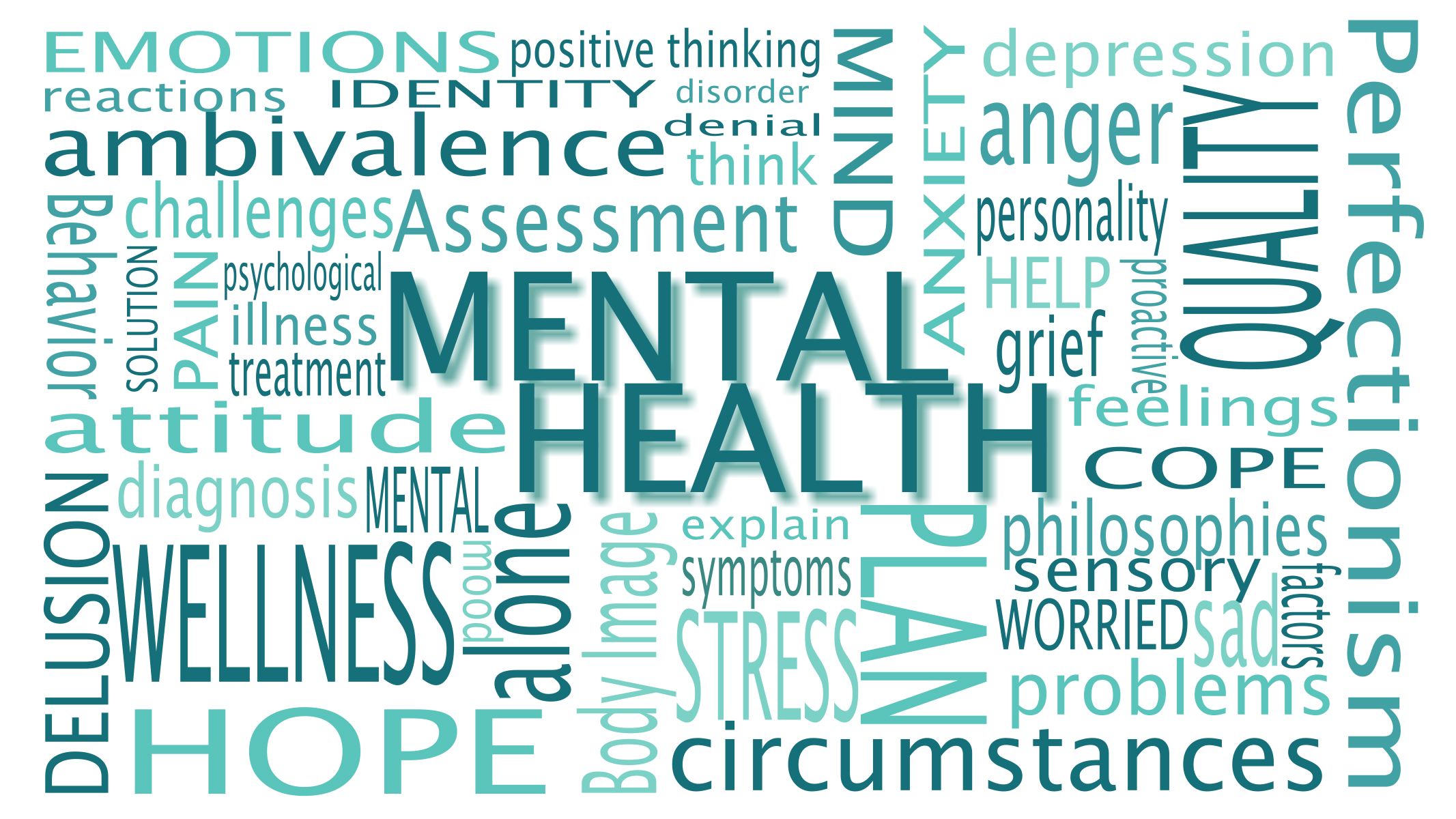What is Mental Health?

“Mental illness… occurs when our mental health is compromised or neglected for so long that it affects our ability to function in our everyday life.”
– Kati Morton, 2018
- According to the World Health Organization (WHO), mental health is “a state of well-being in which the individual realizes his or her own abilities, can cope with the normal stresses of life, can work productively and fruitfully, and is able to make a contribution to his or her community”.
- According to Medilexicon’s medical dictionary, mental health is: “Emotional, behavioral, and social maturity or normality; the absence of a mental or behavioral disorder; a state of psychological well-being in which one has achieved a satisfactory integration of one’s instinctual drives acceptable to both oneself and one’s social milieu; an appropriate balance of love, work, and leisure pursuits.”
- Mental health is a psychological state of well-being, characterized by continuing personal growth, a sense of purpose in life, self-acceptance, and positive relations with others.
- Mental health is a relative state of mind in which a person is able to cope with and adjust to the recurrent stresses of everyday living in an acceptable way.
- Mental health is a state of psychological and emotional well-being that enables an individual to work, love, relate to others effectively, and resolve conflicts.
Some people define mental health as the absence of mental illness, but many psychologists consider this definition too narrow. The WHO also stresses that mental health “is not just the absence of a mental disorder”. The term “mental health” can also refer to a broad and growing multidisciplinary field of research encompassing both mental health and mental illness.
Elements of Mental Health
Psychologists have identified a number of distinct dimensions of mental health. These include self-acceptance, or self-esteem, characterized by a positive evaluation of oneself and one’s past experiences; personal growth reflected in one’s sense of continued psychological growth and development; a sense that one’s life has purpose and meaning; positive relations with others; environmental mastery, the capacity to manage effectively in the surrounding world; and autonomy, a sense of self-determination and the ability to control one’s own life. Self-acceptance, relations with others, environmental mastery, and autonomy usually improve as a person ages and gains life experience. However, many people find that their personal growth and sense of purpose in life begin to decline in midlife.
Some psychologists regard mental health as the ability to maintain a balance between positive and negative emotions, such as elation and sadness. In this view, a person who displays emotional extremes in either direction is less well-adjusted. Other psychologists emphasize the role of one’s environment in influencing well-being. This perspective sees mental health reflected in a person’s overall happiness with various domains of life, such as social relationships, family, work, leisure, health and community life.
Factors that influence Mental Health
A number of different aspects of life can influence mental health. In a mid-1970s study of people living in the United States, researchers identified critical areas that influence one’s mental health. These areas are working life, family life, and the social role that one occupies in the community. Negative experiences in these areas, such as an unreasonable boss or a turbulent family life, can reduce one’s overall sense of well-being and happiness. Apart from these basic factors, today good health is also considered a vital element for happiness and better mental health.
Another important influence on mental health is stress. In general, people experience stress when the demands placed on them exceed the resources they have available to meet those demands. Significant sources of stress include major life events, such as divorce, death of a spouse, loss of a job, and illness in the family. These events can overwhelm a person’s ability to cope and function effectively. In addition, one source of stress may lead to another, as when financial hardship follows job loss. People who experience unusually traumatic events, such as rape and natural disasters, may develop post-traumatic stress disorder (PTSD)
Stress influences both mental health as well as physical health. People who experience a high level of stress for a long time (called chronic stress) — and who cope poorly with this stress—may become irritable, socially withdrawn, and emotionally unstable. They may also have difficulty concentrating and solving problems. Some people under intense and prolonged stress may start to suffer from extreme anxiety, depression, or other severe emotional or psychological problems. Anxiety disorders caused by stress may include generalized anxiety disorder, phobias, panic disorder, and obsessive-compulsive disorder. People who survive catastrophes sometimes develop an anxiety disorder called post-traumatic stress disorder (PTSD). They re-experience the traumatic event again and again in dreams and in disturbing memories or flashbacks during the day. They often seem emotionally numb and may be easily startled or angered.
People may also experience chronic stress when confronted with a continuing set of demands that reduce their ability to function. Examples of such demands include working long hours under difficult circumstances and caring for a chronically ill relative. Economic hardship, unemployment, and poverty can also produce chronic stress and undermine mental health.
Some studies suggest that genetic factors or genetics may partly determine one’s level of happiness and mental health. People seem to display a characteristic level of well-being, with some people usually feeling happy and others typically feeling sad or unhappy. Researchers have found that although people’s moods change in response to both positive and negative events, the effect wears off over time. For example, people who win the lottery or receive an unexpected promotion may feel happier at first, but over time they return to their former characteristic level of mental health. Research suggests that one’s genetic background—that is, the genes inherited from one’s parents—explains more than half of the differences in people’s characteristic mood levels. Genes may also partly determine the range of ups and downs that people feel, including whether people have large mood swings or remain stable from day to day.
Maintaining Mental Health
The ability to cope with adversity can be crucial for the mental health of the individual. Coping means successfully dealing with problems that arise in life. People differ substantially in the way they cope with adversity. Some people engage in emotion-focused coping, a strategy that focuses on managing one’s emotions. Examples of this coping strategy include distracting one’s attention from the problem, denying the problem, venting one’s emotions, or sharing emotions with others. A second form of coping, problem-focused coping, involves efforts to reduce stress by solving the problem. People who use this strategy take active steps to overcome the problem, such as seeing a counselor or a psychotherapist to repair a relationship or looking for a new job in response to problems at work. They may also seek advice from friends and family members.
Some people use coping skills more effectively than others. However, research has shown that people can learn new coping skills. For example, counselors can teach children how to handle difficulties in school. Adults can be taught skills to cope with stressful life events, such as job loss and divorce. Teaching people coping skills before they encounter adversity, or early in the stages of a crisis, appears an effective method of preventing poor mental health. Learning effective coping strategies also directly improves mental health by improving one’s sense of mastery and self-esteem.
Social support from friends and family members also promotes good mental health. This support can take several forms. Other people can offer concrete help in a crisis, such as providing shelter to families victimized by a natural disaster or alerting an unemployed person to a job opportunity. In addition, other people can provide an important source of emotional support. Friends respond with concern, empathy, and advice to a person facing difficulties or loss. They boost confidence and self-esteem by offering reassurance and compliments. Self-help groups provide support by enabling people with similar problems to share their experiences and emotions. Conversely, research has shown that negative social interactions, such as constant criticism and belittlement from other people, can undermine mental health.
Other ways of maintaining good mental health involve physical activities. For example, research has shown that regular aerobic exercise helps to boost self-esteem, relieve depression, and improve concentration. Relaxation techniques, such as deep breathing and meditation, also help to combat the effects of stress.
As such, achieving mental health is about striking a balance in the social, physical, spiritual, economic and mental aspects of our lives. Reaching a balance is a learning process and it is ongoing. At times, we may tip the balance too much in one direction and have to find our footing again. Our personal balance is highly individual, and our challenge is to stay mentally healthy by finding and keeping that balance.
In conclusion and to summarize, positive mental health is all about :
- Feeling in control (of our life in general)
- Being able to make rational decisions
- Being in touch with our feelings (self-awareness and emotional regulation)
- Being able to form positive relationships
- Feeling good about ourselves (self-esteem)
- Knowing how to look after ourselves (self-care)
- Knowing when and where to seek professional help
“All stress, anxiety, depression, is caused when we ignore who we are, and start living to please others.”
– Paulo Coelho, 2014
The Public Health Agency of Canada defines mental health / psychological well-being as:
The capacities of each and all of us to feel, think, and act in ways that enhance our ability to enjoy life and deal with the challenges we face. It is a positive sense of emotional and spiritual well-being that respects the importance of culture, equity, social justice, interconnections, and personal dignity.
In the table below, the mental health continuum ranges from optimal (or flourishing) to minimal (or languishing), whereas the mental illness continuum ranges from no mental illness to serious mental illness.
Mental health is best understood as a matrix, where people can move among states of mental well-being regardless of mental illness. They can flourish or languish, depending on individual functioning, social well- being and mental health issues.
Therefore, a person with mental illness may flourish and, conversely, someone without mental illness may languish with less than optimal mental health. People diagnosed with a mental illness can still have high levels of general mental well-being, while those without a diagnosed mental illness can show low levels of mental well-being.
In the model below, people who are healthy (green) can go through mild and reversible distress or functional impairment (yellow), to more severe, persistent injury or impairment (orange), to clinical illnesses and disorders requiring more concentrated medical care (red).
The arrows under the four colour blocks suggest a continuum, with movement in both directions along the continuum, indicating that there is always the possibility for a return to full health and functioning. In this way, no one is written off simply because they are showing symptoms of an illness, or are being treated for a disorder or disease. There is also a recognition that the earlier that intervention of some sort is provided, the easier it is to return to full health and functioning (green).
These two models emphasize that mental health is not simply the absence of mental illness. You may not have control over your mental illness, but you can strengthen your mental health!

10 Common Mental Illnesses Crash Course
What is Mental Health Recovery?
Watch Video below:



